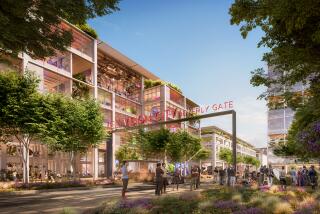Troubled Project May Lose Atrium, Big Hotel
- Share via
WEST COVINA — The problem-plagued Atrium project, which has been on the drawing board for seven years, may have lost its namesake glass structure and a major hotel, developers say.
In the latest setback, the developer, Watt Investment Properties, said it is unlikely that a Holiday Inn will be a part of the business complex. The hotel had been planned as an anchor of the $157-million project.
And Watt said it is also doubtful that the atrium, a four-story glass structure connecting the hotel with two office buildings, will be included.
Despite the setback, and the checkered history of a project that has changed hands three times since it was proposed in 1979, city officials are optimistic that the complex will be completed.
Complicated Industry
“The problems are not new to the development industry,” said Chester Yoshizaki, city redevelopment agency manager. “It’s just unusual for West Covina because this is one of the largest projects we’ve undertaken.”
He pointed out that it is a mixed-use development with different land uses concentrated on one site. “The key in mixed-use projects is getting all the pieces of the puzzle together at the same time.”
The idea behind the project is to have a “complete environment,” with office space, hotel, meeting rooms, shops and restaurants in one area, Yoshizaki said.
Officials from Watt and the Redevelopment Agency have been meeting twice weekly to redesign plans for the first phase of the complex that exclude the hotel and the atrium.
“I don’t think the Holiday Inn is a viable player right now,” said Roger O. Williams, vice president of Watt, which is developing the 21.5-acre site. “We have not given up any possibility, but I think it’s unlikely.”
‘Taking a Step Back’
Kris Stewart, a spokeswoman for Memphis-based Holiday Corp., said her company is “taking a step back and determining what is in the best interest of the Holiday Inn.”
The first phase of the revised plan calls for two 4-story, 90,000-square-foot office buildings. A second phase would include two 12-story, 200,000-square-foot office buildings, another 20,000 square feet of retail space and a hotel.
Under Watt’s old schedule, construction of the first phase was to have begun this spring.
Now, however, Watt hopes to start construction on the two office buildings in the fall or by the end of the year.
Problems developed over the hotel’s size, and each side blames the other for what has happened.
Watt says Holiday wanted to reduce the hotel to 180 rooms from 310. That was unacceptable, Williams said.
But Stewart said it was Watt that wanted a smaller hotel, a prospect that prompted Holiday to reconsider its involvement.
“The owners (Watt) did not want to build as dramatic a hotel,” Stewart said.
Williams tied the hotel problem to a recent attempt by New York investor Donald Trump to take over Holiday Corp., saying that the effort to halt the takeover tied up the company’s funds. But Stewart denied that the takeover played a role in the decision, even though it put the company $2.4 billion in debt.
Williams said he still hopes that a hotel will be included and that Watt is looking “at the problem with Holiday as an opportunity to upgrade the operation.
“We were not the original developers. We more or less inherited the Holiday Inn.”
Watt, which began negotiations with the city a year ago, is the third developer for the project planned for a triangular site bounded by State Street, Glendora Avenue and the San Bernardino Freeway.
The city began negotiating the project in 1979 with COGO, a joint-venture development group that agreed to build two five-story buildings, one to house a hotel and the other to house an office building. COGO pulled out in 1980 because one of its partners could not follow through with the project, city officials said.
Equidon Investment Builders of Irvine, hired by the Redevelopment Agency in 1983 to take over the project, agreed to include an atrium connecting the hotel and two eight-story office buildings. Construction was to begin in early 1984 but was delayed, and the agreement with Equidon fell through in 1985 because the firm had overextended itself in other development projects, city officials said.
Yoshizaki said the atrium was Equidon’s idea to be used as a marketing tool to attract businesses.
The city has spent $9.2 million to acquire the site, the oldest commercial area in West Covina, and relocate about 70 businesses. The city is still obligated to pay for up to $500,000 in land improvements.
Officials had expected the development, including the hotel, to generate $400,000 in property taxes, $350,000 in bed tax, $76,000 in sales tax and $190,000 in business license fees each year.
But without the hotel, the figures have been drastically reduced. Yoshizaki said he expects that the scaled-down project will bring in only $220,000 in property tax and $175,000 in business license fees each year.
More to Read
Sign up for Essential California
The most important California stories and recommendations in your inbox every morning.
You may occasionally receive promotional content from the Los Angeles Times.






